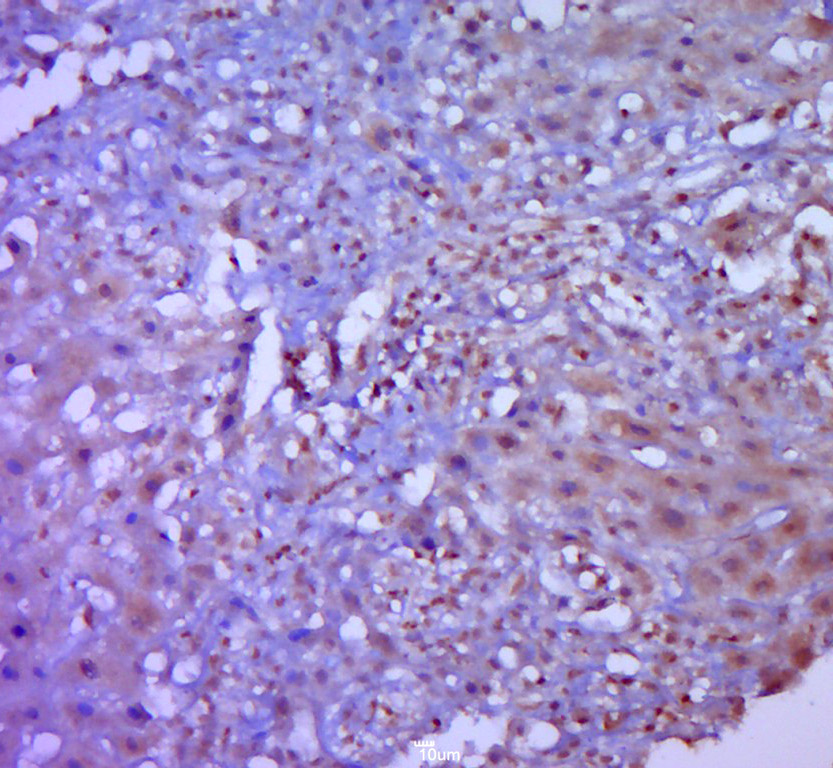
Mouse Anti-NOTCH3 antibody
CADASIL; CASIL; NOTC3_HUMAN; Notch 3; Notch 3 intracellular domain; Notch homolog 3; Notch3.
View History [Clear]
Details
Product Name NOTCH3 Chinese Name 跨膜受体蛋白Notch-3单克隆抗体 Alias CADASIL; CASIL; NOTC3_HUMAN; Notch 3; Notch 3 intracellular domain; Notch homolog 3; Notch3. Immunogen Species Mouse Clonality Monoclonal Clone NO. 6G2 React Species Human, Applications WB=1:100-500 IHC-P=1:100-500 (Paraffin sections need antigen repair)
not yet tested in other applications.
optimal dilutions/concentrations should be determined by the end user.Theoretical molecular weight 255kDa Cellular localization The nucleus The cell membrane Form Liquid Concentration 1mg/ml immunogen KLH conjugated synthetic peptide derived from human NOTCH3: 2291-2321 Lsotype IgG Purification affinity purified by Protein G Buffer Solution 0.01M TBS(pH7.4) with 1% BSA, 0.03% Proclin300 and 50% Glycerol. Storage Shipped at 4℃. Store at -20 °C for one year. Avoid repeated freeze/thaw cycles. Attention This product as supplied is intended for research use only, not for use in human, therapeutic or diagnostic applications. PubMed PubMed Product Detail This gene encodes the third discovered human homologue of the Drosophilia melanogaster type I membrane protein notch. In Drosophilia, notch interaction with its cell-bound ligands (delta, serrate) establishes an intercellular signalling pathway that plays a key role in neural development. Homologues of the notch-ligands have also been identified in human, but precise interactions between these ligands and the human notch homologues remains to be determined. Mutations in NOTCH3 have been identified as the underlying cause of cerebral autosomal dominant arteriopathy with subcortical infarcts and leukoencephalopathy (CADASIL). [provided by RefSeq, Jul 2008]
Function:
Functions as a receptor for membrane-bound ligands Jagged1, Jagged2 and Delta1 to regulate cell-fate determination. Upon ligand activation through the released notch intracellular domain (NICD) it forms a transcriptional activator complex with RBPJ/RBPSUH and activates genes of the enhancer of split locus. Affects the implementation of differentiation, proliferation and apoptotic programs.
Subunit:
Heterodimer of a C-terminal fragment N(TM) and a N-terminal fragment N(EC) which are probably linked by disulfide bonds. Interacts with MAML1, MAML2 and MAML3 which act as transcriptional coactivators for NOTCH3. Interacts with PSMA1. Interacts with HIF1AN.
Subcellular Location:
Cell membrane; Single-pass type I membrane protein.
Notch 3 intracellular domain: Nucleus. Note=Following proteolytical processing NICD is translocated to the nucleus.
Tissue Specificity:
Ubiquitously expressed in fetal and adult tissues.
Post-translational modifications:
Synthesized in the endoplasmic reticulum as an inactive form which is proteolytically cleaved by a furin-like convertase in the trans-Golgi network before it reaches the plasma membrane to yield an active, ligand-accessible form. Cleavage results in a C-terminal fragment N(TM) and a N-terminal fragment N(EC). Following ligand binding, it is cleaved by TNF-alpha converting enzyme (TACE) to yield a membrane-associated intermediate fragment called notch extracellular truncation (NEXT). This fragment is then cleaved by presenilin dependent gamma-secretase to release a notch-derived peptide containing the intracellular domain (NICD) from the membrane.
Phosphorylated.
Hydroxylated by HIF1AN.
DISEASE:
Cerebral arteriopathy with subcortical infarcts and leukoencephalopathy, autosomal dominant (CADASIL) [MIM:125310]: A cerebrovascular disease characterized by multiple subcortical infarcts, pseudobulbar palsy, dementia, and the presence of granular deposits in small cerebral arteries producing ischemic stroke. Note=The disease is caused by mutations affecting the gene represented in this entry.
Myofibromatosis, infantile 2 (IMF2) [MIM:615293]: A rare mesenchymal disorder characterized by the development of benign tumors in the skin, striated muscles, bones, and, more rarely, visceral organs. Subcutaneous or soft tissue nodules commonly involve the skin of the head, neck, and trunk. Skeletal and muscular lesions occur in about half of the patients. Lesions may be solitary or multicentric, and they may be present at birth or become apparent in early infancy or occasionally in adult life. Visceral lesions are associated with high morbidity and mortality. Note=The disease is caused by mutations affecting the gene represented in this entry.
Similarity:
Belongs to the NOTCH family.
Contains 5 ANK repeats.
Contains 34 EGF-like domains.
Contains 3 LNR (Lin/Notch) repeats.
SWISS:
Q9UM47
Gene ID:
4854
Database links:Entrez Gene: 4854 Human
Entrez Gene: 18131 Mouse
Omim: 600276 Human
SwissProt: Q9UM47 Human
SwissProt: Q61982 Mouse
Unigene: 8546 Human
Unigene: 439741 Mouse
Unigene: 53876 Rat
Product Picture
References (0)
No References
Bought notes(bought amounts latest0)
No one bought this product
User Comment(Total0User Comment Num)
- No comment



 +86 571 56623320
+86 571 56623320
 +86 18668110335
+86 18668110335

